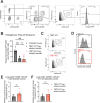This is a preprint.
FOXP3+ Regulatory T Cells Require TBET to Regulate Activated CD8+ T Cells During Recovery from Influenza Infection
- PMID: 38853959
- PMCID: PMC11160713
- DOI: 10.1101/2024.05.30.596295
FOXP3+ Regulatory T Cells Require TBET to Regulate Activated CD8+ T Cells During Recovery from Influenza Infection
Update in
-
Regulatory T Cells Require TBET to Regulate Activated CD8+ T Cells During Recovery from Influenza.Am J Respir Cell Mol Biol. 2025 Apr;72(4):453-456. doi: 10.1165/rcmb.2024-0254LE. Am J Respir Cell Mol Biol. 2025. PMID: 40167310 No abstract available.
Abstract
FOXP3+ regulatory T (Treg) cells are necessary to coordinate resolution of lung inflammation and a return to homeostasis after respiratory viral infections, but the specific molecular requirements for these functions and the cell types governed by Treg cells remain unclear. This question holds significance as clinical trials of Treg cell transfer therapy for respiratory viral infection are being planned and executed. Here, we report causal experiments in mice determining that Treg cells are necessary to control the numbers of activated CD8+ T cells during recovery from influenza infection. Using a genetic strategy paired with adoptive transfer techniques, we determined that Treg cells require the transcription factor TBET to regulate these potentially pro-inflammatory CD8+ T cells. Surprisingly, we found that Treg cells are dispensable for the generation of CD8+ lung tissue resident-memory T (Trm) cells yet similarly influence the transcriptional programming of CD8+ Trm and activated T cells. Our study highlights the role of Treg cells in regulating the CD8+ T cell response during recovery from influenza infection.
Conflict of interest statement
Competing Interest Statement: NM is currently an employee and owns stock in Vertex Pharmaceuticals. BDS holds United States Patent No. US 10,905,706 B2, Compositions and Methods to Accelerate Resolution of Acute Lung Inflammation, and serves on the Scientific Advisory Board of Zoe Biosciences. The other authors have no competing interests to declare.
Figures



Similar articles
-
CD8+ Treg cells suppress CD8+ T cell-responses by IL-10-dependent mechanism during H5N1 influenza virus infection.Eur J Immunol. 2014 Jan;44(1):103-14. doi: 10.1002/eji.201343583. Epub 2013 Nov 4. Eur J Immunol. 2014. PMID: 24114149 Free PMC article.
-
PD-1 and ICOS counter-regulate tissue resident regulatory T cell development and IL-10 production during flu.Front Immunol. 2022 Sep 8;13:984476. doi: 10.3389/fimmu.2022.984476. eCollection 2022. Front Immunol. 2022. PMID: 36159872 Free PMC article.
-
Limited Foxp3+ Regulatory T Cells Response During Acute Trypanosoma cruzi Infection Is Required to Allow the Emergence of Robust Parasite-Specific CD8+ T Cell Immunity.Front Immunol. 2018 Nov 5;9:2555. doi: 10.3389/fimmu.2018.02555. eCollection 2018. Front Immunol. 2018. PMID: 30455700 Free PMC article.
-
Persistence in Temporary Lung Niches: A Survival Strategy of Lung-Resident Memory CD8+ T Cells.Viral Immunol. 2017 Jul/Aug;30(6):438-450. doi: 10.1089/vim.2017.0016. Epub 2017 Apr 18. Viral Immunol. 2017. PMID: 28418771 Free PMC article. Review.
-
Thymic commitment of regulatory T cells is a pathway of TCR-dependent selection that isolates repertoires undergoing positive or negative selection.Curr Top Microbiol Immunol. 2005;293:43-71. doi: 10.1007/3-540-27702-1_3. Curr Top Microbiol Immunol. 2005. PMID: 15981475 Review.
References
-
- Ferreira C, Barros L, Baptista M, Blankenhaus B, Barros A, Figueiredo-Campos P, Konjar S, Laine A, Kamenjarin N, Stojanovic A, Cerwenka A, Probst HC, Marie JC, Veldhoen M. Type 1 T(reg) cells promote the generation of CD8(+) tissue-resident memory T cells. Nat Immunol 2020;21(7):766–776. - PubMed
Publication types
Grants and funding
- R01 HL153122/HL/NHLBI NIH HHS/United States
- U19 AI181102/AI/NIAID NIH HHS/United States
- K08 HL159356/HL/NHLBI NIH HHS/United States
- S10 OD011996/OD/NIH HHS/United States
- P01 AG049665/AG/NIA NIH HHS/United States
- U19 AI135964/AI/NIAID NIH HHS/United States
- P30 CA060553/CA/NCI NIH HHS/United States
- P01 HL154998/HL/NHLBI NIH HHS/United States
- T32 AI083216/AI/NIAID NIH HHS/United States
- F31 HL162490/HL/NHLBI NIH HHS/United States
- R01 HL149883/HL/NHLBI NIH HHS/United States
- T32 GM144295/GM/NIGMS NIH HHS/United States
- F32 HL162418/HL/NHLBI NIH HHS/United States
- T32 HL076139/HL/NHLBI NIH HHS/United States
LinkOut - more resources
Full Text Sources
Research Materials
